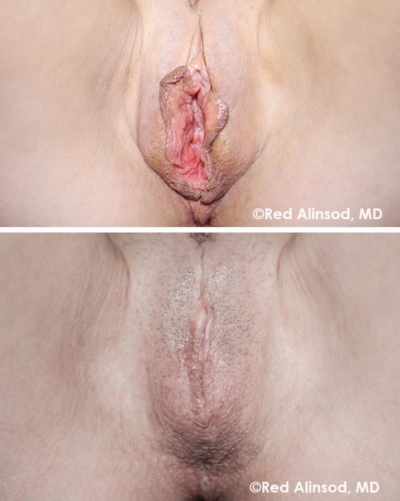Vaginal Rejuvenation / Vaginoplasty
The goal of this surgery is to narrow the full-length diameter and circumference of the vagina and increase friction during sex. This surgery is like replacing the old carpet and saggy floor with new rebar reinforced foundation, wood floors, and tight carpeting. This is not a Perineoplasty which just deals with the outside appearance and only tightens the opening of the vagina. Most plastic surgeons perform perineoplasties for their tightening procedures and call them Vaginoplasty or Vaginal Rejuvenation surgery. Those are NOT full-length. However, when perineoplasty is done with a full-length vaginoplasty you can recreate the vaginal opening and deep canal as if it was virginal with no signs of babies passing through it. Vaginoplasty is usually done in the operating room under general or spinal anesthesia. I developed the protocols in 2005 for “In-Office Awake No IV Surgery” so that is what I do. I teach this technique to the world’s Top Surgeons and is described in several textbooks written by my graduates. I updated the tried-and-true Pudendal Block and modified it and created the Pudendo-Levator Block to allow the safest deep dive surgeries in my office. This is the safest way to do vaginoplasties. No tubes down your throat, no needles in your spine, no Fantanyl in your bloodstream, no risk for Malignant Hyperthermia (the killer in the OR). If you have a fallen bladder or fallen rectum or need a sling incontinence surgery in the operating room I can add on a vaginoplasty to complete the repair for both function and beauty. I use the most precise and safe devices such as Soniquence Radiofrequency and LightScalpel CO2 Laser. It takes 1-2 hours to do this procedure. You walk out of the office without any pain. You can drive in a week. You will be healed by 6 weeks. You can have sex by 8 weeks.
One more thing. Ask your surgeon if the technique they use is a levatorplasty. This is when you dissect deep in the pelvis, find the levator muscles along the sides of the pelvis, and suture them gently in layers to create a new pelvic floor. In my opinion, this is the best way to get a full-depth vaginal tightening done and is the technique I use in my office. Levatorplasty got a bad rap in gynecologic circles for over a hundred years and was thought to cause more pelvic pain. The old technique used huge bites of tissues that were tied very tightly causing tissue death. That was old literature. The modified and modern way to do them (smaller and more gentle bites of tissues tied approximated loosely) has been found to be quite safe and worked better with no higher rates of pain or painful sex. I have done this for 36 years now. It is all about the surgeon and their experience and skill.


